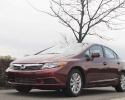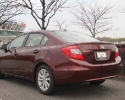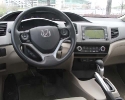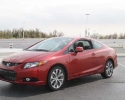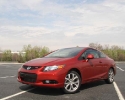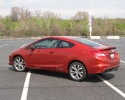2012 Honda Civic Sedan and Coupe
In the midst of the national launch of the 2012 Honda Civic, I had a nostalgic moment. During the early 1980’s, a high school friend showed up with a 1978 Civic. It turned into the hub of our social life for 3 years. It became the conduit for all the things one encounters on the journey from boy to man. I have a soft spot for this vehicle, the original Civic was my first means of escapism and quasi independence.
It appears most Canadians share my love of the Civic. In 2010, for the 13th consecutive year, the Civic was the number one selling car in Canada. It hasn’t been easy mind you. The Korean manufacturers have been nipping at Honda’s heels for a while now and recently upped the ante with a new Hyundai Elantra and Kia Forte. The Korean sales pitch keyed on price and content – they typically deliver more car for less money than the Civic. Well folks, the Koreans will be heading back to the drawing board shortly.
The new Civic is visually similar to the outgoing model. In fact, outside the staging tent, one row of cars featured a couple 2011 models slotted between the 2012 models. As I walked to get into one of the Civics, a detailer redirected me to the new model – such is the similarity. He suggested I look for the new lines on the hood to tell old and new apart. Subtle changes indeed.
Inside the changes are numerous, but, again, not readily apparent even though Honda says the vehicle is over 90 percent new. While the overall length is similar to the previous model, the wheelbase has been shortened slightly. Thankfully, the interior space remains more or less the same.
Aside form the new lines on the hood, a keen eye will note the thinner “A” pillars framing the windshield. Understanding the level of engineering required to make this adjustment bolsters the argument that the vehicle is indeed nearly all new. The better visibility provided by the thinner pillars certainly improves things. Mechanically, the standard 140 horsepower engine is a carry over from the previous model, although Honda has integrated an Eco system that, at the push of a button, changes the drive-by-wire throttle system, automatic transmission shift points and cuts the air-conditioning run time to improve fuel economy.
The new Civic comes in 5 trim levels – DX, LX, EX, EX-L and Si. All trim levels above DX are offered in coupe or sedan form. A Hybrid sedan will follow at a later date.
The DX sedan comes equipped with a five-speed manual transmission, Honda’s new Eco assist system, power windows, a four speaker 160 watt AM/FM/CD system with MP3/aux input, tilt and telescopic steering, four-wheel antilock brakes and vehicle stability control. It lists for $14,995. The notable omission here is air-conditioning – it is not an option on the vehicle.
The LX adds remote entry, power door locks, bluetooth connectivity, air-conditioning and an available automatic transmission for $17,490. The EX offers more luxury in the form of a power moonroof, leather wrapped steering wheel and 16-inch alloy wheels, four-wheel disc brakes (rear drums are standard on the lesser models), amongst other niceties for a starting price of $19,490. The EX-L steps up with a satellite-based navigation system as standard equipment, along with leather seats (the front ones heated) and a host of other convenience features for $24,390.
Inside, the new Civic’s dashboard is reminiscent of the outgoing model with its split level arrangement. A digital speedo sits atop a conventional round tachymeter in the viewing space between the steering spokes. Off to the right an angled console, which houses the navi system in higher end models, faces the driver. It serves to cap off the rich feel imparted by the reworked cabin.
The Si coupe versions we drove (there is a sedan this time around as well) were nicely optioned – essentially the EX-L in terms of content, but with a sportier 201 hp engine. The Si starts at $25,990.
On road, the Civic demonstrates why it has earned the title as Canada’s best selling car. The sedans driven were models of refinement. Yes, it is a carryover engine, however, it still possesses a balance of sporting character and fuel efficiency. The engine revs freely and responds with a sound that is neither overly thrashy or harsh in tone. The five-speed automatic transmission in the tester shifted smoothly and was the perfect compliment to the refined engine.
Honda has supplied fuel economy figures that are significantly improved compared to the outgoing model. With a manual transmission, the Civic is slated to return 7.2 L/100km in the city and 5.4 L/100km on the highway, and that is on regular gas.
The Si benefits from the addition of the Acura TSX’s 2.4L engine – it raises the stakes for this range-topping Civic. Not only does the engine come with 201HP, the iVTEC system puts a good chunk of the engine’s 170 lb-ft of torque in lower revs where it is most usable. The Si is only available with a six-speed manual gearbox. It features close ratios and a refined gate.
The Si powertrain heightens the driving experience with its angry gnashing of mechanical teeth.
The 2.4L engine revs readily to its 7,000 rpm redline. Honda spend considerable time tuning not only the performance of this engine but also the sounds emanating from under the hood and from the exhaust. Suspension enhancements serve to match the cars sporting appearance, as became very clear on closed autocross circuit on the grounds of FedEx field, home to the Washington Redskins. The Si coupe was a delight to toss into corners and the spirited throttle response left me smiling throughout the testing day. The pocket-rocket racer crowd will be more than happy with this new Si. The downside to the Si engine is that it requires premium gas. It is also thirstier than the 1.8L engine.
Inside, the cabin’s sporty black interior is tastefully contrasted by shiny metallic trim and Si logos emblazoned on the sports buckets in red stitching. Honda had been producing performance versions of the Civic for decades and has learned a few things over the years. This is the most potent and appealing Si to date.
It was funny to hear some journalists at the press launch muttering about the evolutionary nature of the design and the fact that the there was no new engine or six-speed automatic transmission (Honda figures five is fine). The truth is I have driven some of the Civic’s competitors, and yes some do have new engines and features six speeds. Regardless, they fail to yield better fuel economy than the latest Civic. Nor do they touch the Civic in overal refinement.
As good as this Civic is this is likely the year the Civic will falter and lose its title as the best selling car in Canada. The devastating earthquake in Japan earlier this year has affected the supply of parts to the plant in Alliston, Ontario, where the Civic is built. Honda has forecast a reduction in production until at least the end of 2011 when the flow of parts will return to normal levels.
Copyright © Auto Reviews Online 2016 | Privacy & Terms of Use | info@autoreviewsonline.com | Website by Brolly Media


